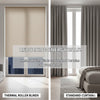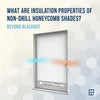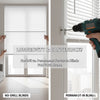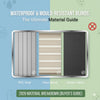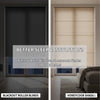Are Wooden Blinds Suitable for Kitchens and Bathrooms?
- by Giorgi Gogidze

When it comes to choosing window treatments for kitchens and bathrooms, homeowners often find themselves torn between aesthetics and practicality. Wooden blinds represent one of the most elegant and timeless window covering options available, offering natural beauty, excellent light control, and sophisticated style. However, kitchens and bathrooms present unique environmental challenges that can make selecting appropriate window treatments particularly complex.
[toc]
The decision to install wooden blinds for windows in moisture-rich environments requires careful consideration of multiple factors including humidity levels, ventilation quality, maintenance requirements, and long-term durability. These rooms experience temperature fluctuations, steam exposure, cooking grease, and frequent cleaning needs that can potentially impact the performance and longevity of wood window treatments.
Understanding the relationship between wood materials and high-moisture environments is crucial for making an informed decision. While some types of wooden blinds can perform admirably in kitchens and bathrooms with proper selection and care, others may be completely unsuitable for these demanding conditions. The key lies in understanding which wood types, treatments, and installation considerations can make wooden blinds a viable option for these challenging spaces.
This comprehensive guide examines the practicality, benefits, and potential drawbacks of choosing wooden blinds for kitchens and bathrooms, helping you make an informed decision that balances style, functionality, and longevity.
Understanding Moisture Challenges in Kitchens and Bathrooms
Kitchens and bathrooms create some of the most challenging environments for wooden blinds for windows due to their inherently high moisture levels. In bathrooms, hot showers generate substantial steam that can saturate the air with humidity levels often exceeding 70-80%. Similarly, kitchens produce steam from cooking, dishwashing, and food preparation activities that can create persistent moisture in the air.
The primary concern with wood in these environments is its natural tendency to absorb moisture from the surrounding air. When wood absorbs water, it expands, and when it dries, it contracts. This constant expansion and contraction cycle can lead to warping, cracking, splitting, and eventual deterioration of wooden window treatments. The severity of these effects depends on several factors including wood type, finishing quality, ventilation effectiveness, and maintenance practices.
Temperature fluctuations compound moisture-related challenges in both kitchens and bathrooms. Rapid changes from hot, humid conditions to cooler, drier states accelerate the expansion and contraction cycles that stress wood materials. In kitchens, heat from ovens, stovetops, and other appliances can create localized hot spots that further challenge wooden blinds positioned near these heat sources.
Grease and cooking vapors in kitchens present additional challenges beyond simple moisture. These substances can accumulate on window treatments, creating sticky residues that attract dust and dirt while potentially staining or damaging wood finishes. Bathroom products like hairspray, cleaning chemicals, and cosmetics can have similar effects on wooden surfaces.
Benefits of White Wooden Blinds in Moisture-Rich Environments
Despite the challenges, white wooden blinds offer several advantages that make them attractive options for kitchens and bathrooms when properly selected and maintained. The light color of white wooden blinds helps reflect heat and light, which can be particularly beneficial in rooms that already generate substantial heat and humidity. This reflective quality can help moderate temperature fluctuations that stress wood materials.
White wooden venetian blinds provide exceptional light control capabilities that are highly valued in both kitchens and bathrooms. The ability to adjust slat angles allows for precise control of natural light while maintaining privacy – crucial considerations in rooms where tasks requiring good visibility are performed regularly. The clean, bright appearance of white wooden blinds also enhances the sense of cleanliness and spaciousness that's particularly important in utilitarian spaces.
The timeless appeal of white wooden venetian blinds complements virtually any decorating scheme, from traditional to contemporary styles. This versatility is especially valuable in kitchens and bathrooms, which often undergo renovations and style updates more frequently than other rooms. Quality white wooden blinds can adapt to changing design trends while maintaining their classic appeal.
From a practical standpoint, white wooden blinds show dust and dirt more readily than darker alternatives, which actually encourages more frequent cleaning and maintenance. This increased attention to cleanliness can help preserve the blinds' appearance and functionality over time, particularly important in rooms where hygiene and cleanliness are priorities.
Wooden Vertical Blinds: An Alternative Approach
Wooden vertical blinds present a unique alternative to traditional horizontal blinds in kitchen and bathroom applications. The vertical orientation offers several advantages in moisture-rich environments, primarily related to how water and condensation behave on the blind surfaces. Vertical slats allow water droplets to run down naturally rather than pooling in horizontal channels where traditional venetian blinds might trap moisture.
The vertical design also facilitates better air circulation around individual slats, promoting faster drying and reducing the likelihood of sustained moisture contact with wood surfaces. This improved airflow can significantly reduce the risk of mold, mildew, and moisture-related damage that can plague horizontal blind systems in high-humidity environments.
Wooden vertical blinds also offer superior light control for certain window configurations common in kitchens and bathrooms. Large windows, sliding doors, or wide window expanses benefit from the smooth operation and complete coverage that vertical systems provide. The ability to stack vertical slats to one side can completely open views while maintaining the blinds' presence for privacy when needed.
Maintenance considerations for wooden vertical blinds differ from horizontal alternatives. The vertical orientation makes individual slat cleaning easier, as each piece can be accessed and cleaned independently without disturbing adjacent slats. This accessibility is particularly valuable in kitchens where grease accumulation requires regular attention, or in bathrooms where soap residue and product buildup need frequent removal.
The Advantages of Thick White Wooden Blinds
Thick white wooden blinds offer enhanced durability and moisture resistance compared to thinner alternatives, making them more suitable for challenging kitchen and bathroom environments. The increased material thickness provides greater structural stability and resistance to warping and bending that can occur when wood is exposed to moisture and temperature fluctuations.
The substantial construction of thick white wooden blinds also provides better insulation properties, helping to moderate temperature variations that can stress wood materials. This thermal stability is particularly beneficial in bathrooms where hot showers create dramatic temperature swings, or in kitchens where cooking activities generate significant heat.
From an aesthetic standpoint, thick wooden blinds create a more substantial, premium appearance that can enhance the overall design quality of kitchens and bathrooms. The increased visual weight and shadow lines created by thicker slats add architectural interest and sophistication that thinner alternatives cannot match.
The durability advantages of thicker construction extend to hardware and operating mechanisms as well. Heavier slats require more robust tilt mechanisms, cords, and mounting systems, which typically translate to longer-lasting operation and fewer maintenance issues over time. This enhanced durability is particularly valuable in frequently used spaces like kitchens and bathrooms.
Proper Wood Selection and Treatment for Humid Environments
The success of wooden blinds in kitchens and bathrooms depends heavily on selecting appropriate wood types and ensuring proper treatment for moisture resistance. Not all woods perform equally in high-humidity environments, and understanding these differences is crucial for making informed decisions.
Hardwoods generally offer superior moisture resistance compared to softwoods, with species like oak, maple, and cherry providing excellent stability and durability in humid conditions. These dense woods are less prone to rapid moisture absorption and the resulting dimensional changes that can damage blind mechanisms and appearance.
Bamboo, while technically a grass rather than wood, offers exceptional moisture resistance and sustainability benefits that make it an excellent choice for kitchen and bathroom applications. Bamboo's natural moisture resistance and rapid growth characteristics make it both practical and environmentally responsible for humid environments.
Proper sealing and finishing are equally important as wood selection. High-quality polyurethane or lacquer finishes create protective barriers that reduce moisture absorption while maintaining the wood's natural beauty. Multiple coat applications with proper curing between coats ensure comprehensive protection that can withstand the challenging conditions in kitchens and bathrooms.
Installation Considerations for Optimal Performance
Proper installation plays a crucial role in the success of wooden blinds for windows in kitchens and bathrooms. Adequate ventilation around the blinds is essential for preventing moisture accumulation and promoting air circulation that helps wood materials remain stable. Blinds should be mounted with sufficient clearance from walls and window frames to allow air movement.
The proximity to moisture sources requires careful consideration during installation planning. Blinds positioned directly above bathtubs or near kitchen sinks may experience more intense moisture exposure than those in other locations within the same room. Strategic placement and potentially enhanced ventilation in these high-exposure areas can help mitigate risks.
Professional installation ensures proper mounting techniques that account for the weight and stress characteristics of wooden blinds. Quality mounting hardware appropriate for the wall or window frame material prevents sagging and misalignment that can occur when blinds are subjected to thermal expansion and contraction cycles.
Maintenance Requirements for Longevity
Successful long-term performance of wooden blinds in kitchens and bathrooms requires committed maintenance routines that address the unique challenges these environments present. Regular cleaning prevents accumulation of grease, soap residue, and other substances that can damage wood finishes and create hygiene concerns.
Weekly dusting with microfiber cloths or vacuum brush attachments removes surface dirt and prevents buildup that can become more difficult to remove over time. Monthly deeper cleaning with appropriate wood cleaners helps maintain finish integrity while removing stubborn residues that regular dusting cannot address.
Immediate attention to moisture exposure is crucial for preventing damage. After particularly steamy showers or intensive cooking sessions, opening blinds fully and ensuring adequate ventilation helps wood materials return to normal moisture levels quickly. This proactive approach prevents the sustained moisture contact that causes the most significant damage to wooden window treatments.
Alternative Solutions and Hybrid Approaches
For homeowners who love the appearance of wooden blinds but remain concerned about moisture-related challenges, several alternative solutions can provide similar aesthetics with enhanced durability. Faux wood blinds manufactured from composite materials or PVC offer wood-like appearances with superior moisture resistance.
High-quality faux wood alternatives have evolved significantly in recent years, with many options virtually indistinguishable from real wood in appearance while offering complete immunity to moisture-related damage. These alternatives can be particularly appropriate in high-exposure areas like shower-adjacent windows or kitchen backsplash areas.
Hybrid approaches might involve using genuine wooden blinds in lower-risk areas of kitchens and bathrooms while selecting moisture-resistant alternatives for high-exposure locations. This strategy allows homeowners to enjoy the benefits of real wood where conditions permit while ensuring durability where moisture exposure is most intense.
Cost-Benefit Analysis and Long-term Considerations
The decision to install wooden blinds in kitchens and bathrooms should include careful consideration of long-term costs versus benefits. While high-quality wooden blinds represent a significant initial investment, their potential longevity and timeless appeal can provide excellent value when properly selected and maintained.
However, the additional maintenance requirements and potential for moisture-related damage must be factored into the total cost of ownership. More frequent cleaning, potential refinishing needs, and possible premature replacement due to moisture damage can significantly impact the overall value proposition.
The aesthetic and comfort benefits of wooden blinds may justify the additional costs and maintenance requirements for homeowners who prioritize natural materials and classic design elements. The superior light control, insulation properties, and design versatility of quality wooden blinds can enhance daily living experiences in ways that justify their premium positioning.
Conclusion
Wooden blinds can be suitable for kitchens and bathrooms when carefully selected, properly installed, and diligently maintained. The key to success lies in choosing appropriate wood types or treatments, ensuring adequate ventilation, and committing to regular maintenance routines that address the unique challenges these environments present.
White wooden blinds, white wooden venetian blinds, wooden vertical blinds, and thick white wooden blinds each offer specific advantages that can make them viable options for moisture-rich environments. The decision ultimately depends on your specific circumstances, including room ventilation, moisture exposure levels, maintenance commitment, and design priorities.
For homeowners willing to invest in quality materials and ongoing care, wooden blinds for windows can provide years of beautiful, functional service even in challenging kitchen and bathroom environments. However, those seeking lower-maintenance solutions might find that modern faux wood alternatives provide similar aesthetics with reduced risk and maintenance requirements.

